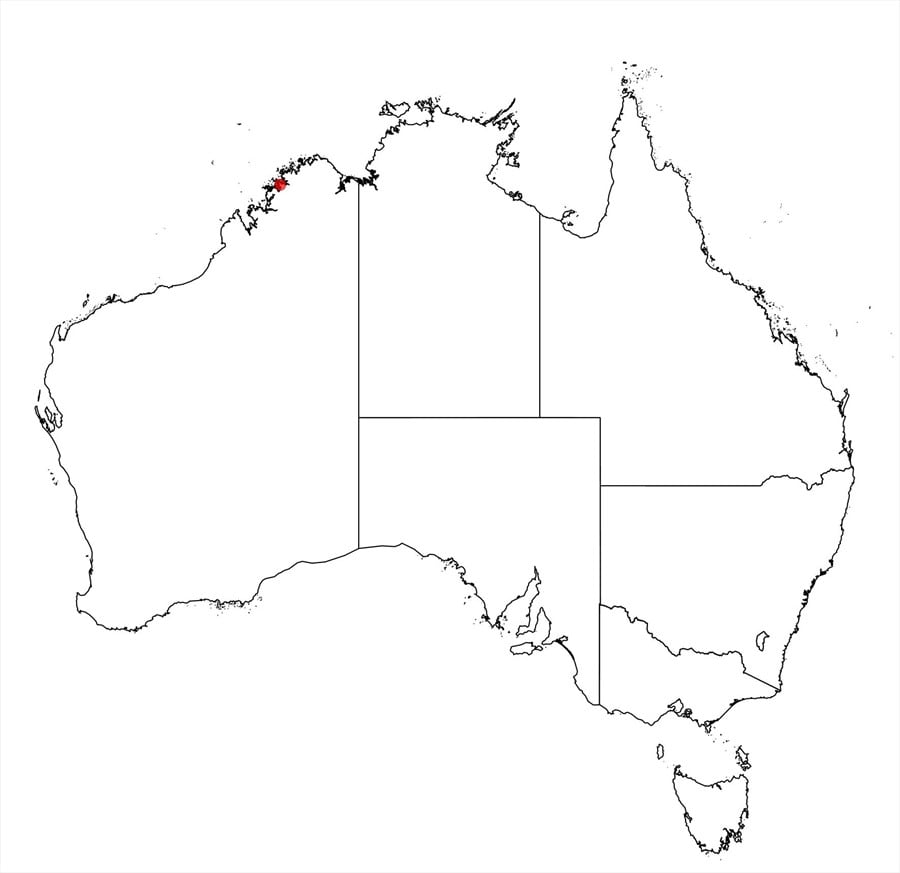Acacia orthotropica Maslin, M.D.Barrett & R.L.Barrett
WATTLE
Acacias of Australia
Common Name
Mt Trafalgar Wattle
Family
Fabaceae
Distribution
Occurs in the Kimberley region of northern W.A. where it is known from only a single population in Prince Regent Natl Park.
Description
Obconic, single-stemmed tree to 4 m tall. Branchlets terete, reddish brown, glabrous. Phyllodes narrowly oblong-oblanceolate, straight, 3–6 cm long, (2.5–)3–5 mm wide, obtuse-mucronate, thinly coriaceous, erect, crowded, somewhat imbricate when dry, glabrous; longitudinal nerves 2 with central one the most pronounced and confluent with lower margin at base, second nerve extending for 2/3–3/4 length of phyllode, secondary nerves openly anastomosing; gland single, 1–3 mm above the pulvinus. Inflorescences simple, initiated within axil of immature phyllodes on new shoots; peduncles 20–30 mm long, slender, irregularly curved or sigmoid when dry, glabrous; heads globular, 30–35-flowered. Bracteoles c. 1 mm long, laminae puberulous with light golden and white hairs. Flowers 5-merous; calyx normally dissected to about the middle (sometimes to the base) into oblong, apically puberulous-hirsutulous lobes, the hairs light golden and white; petals with hairs at apex as on calyx. Pods (dehisced valves) oblong to narrowly oblong, mostly straight-edged, flat, 3–8 cm long, 14–16 mm wide, firmly chartaceous to very thinly crustaceous, glabrous, reticulately nerved, basal stipe 4–5 mm long. Seeds not seen but were seated in shallow, transverse depressions, each separated by a narrow septum.
Phenology
The type was at full anthesis in late Jan.
Habitat
Grows on a broken sandstone slope adjacent to a low basaltic hill, in open shrubland over dense Triodia spp. ground cover.
Specimens
W.A. [precise locality withheld for conservation reasons], 27 Jan. 2010, R.L.Barrett RLB 6527; holo: PERTH; iso: CANB, DNA, K, MEL, NSW, PERTH.
Notes
Most closely related to A. kenneallyi despite its superficially dissimilar appearance; see B.R.Maslin, M.D.Barrett & R.L.Barrett, Nuytsia 23: 572 (2013), for discussion. Acacia kenneallyi is easily distinguished by its pruinose branchlets, much larger, narrowly elliptic phyllodes, often racemose or paniculate inflorescences with more numerously-flowered heads and longer pods with obliquely arranged seeds. Phyllodes superficially similar to those of the arid zone species A. jensenii and some forms of A. melleodora but the relationship is seemingly not close. The latter two species are resinous shrubs with a small gland at their phyllode apices, ¾-united sepals which, together with the petals, are glabrous.
Conservation
Acacia orthotropica is listed as Priority Two under Department of Parks and Wildlife Conservation Codes for Western Australian Flora.
FOA Reference
Flora of Australia Project
Author
B.R.Maslin
This identification key and fact sheets are available as a mobile application:
URL: https://apps.lucidcentral.org/wattle/
© Copyright 2018. All rights reserved.






